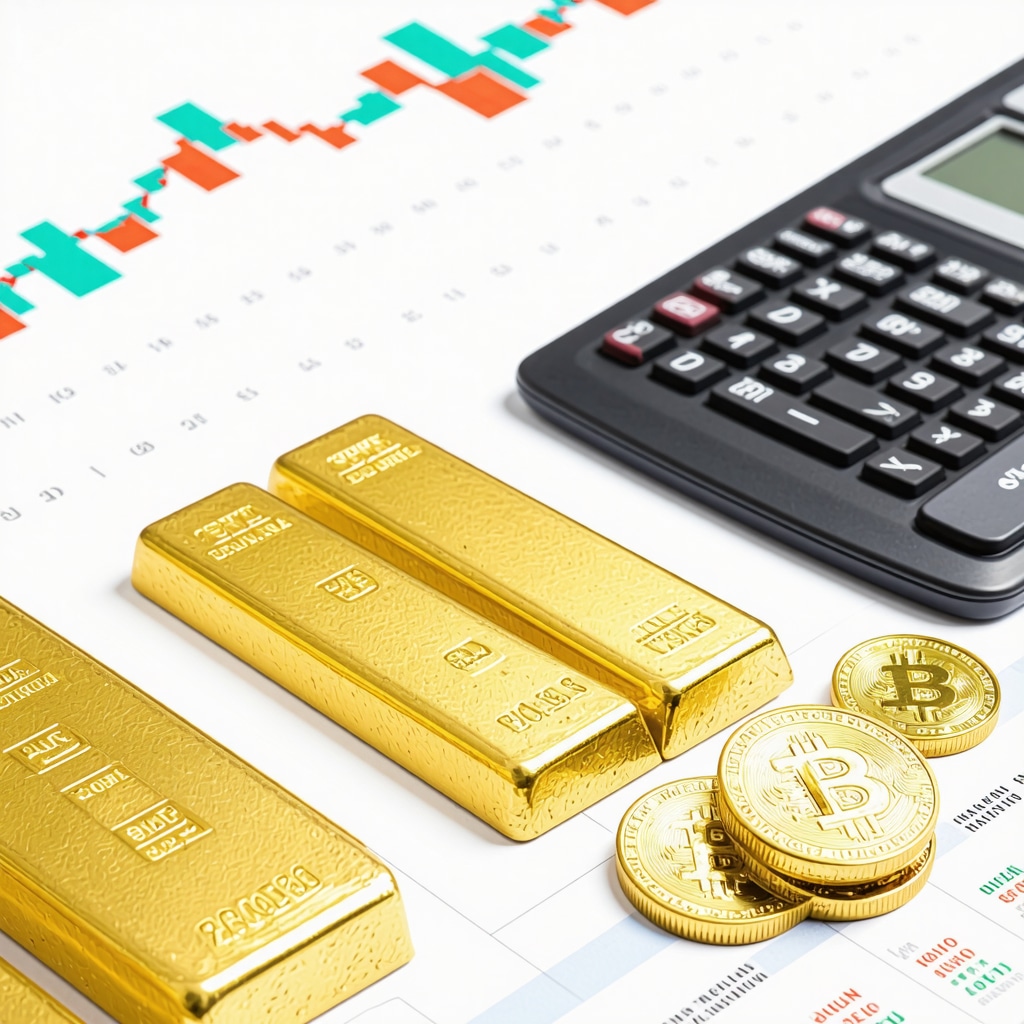Unlocking the Golden Shield: Why Gold Remains a Timeless Wealth Protector
In today’s volatile economic landscape, safeguarding your wealth demands more than conventional asset allocations. Gold investment strategies continue to captivate discerning investors aiming to shield their portfolios from inflation, currency fluctuations, and geopolitical uncertainties. Unlike fleeting market trends, gold offers enduring intrinsic value, making it a cornerstone for preserving purchasing power. This year, understanding nuanced approaches to gold investing can transform your wealth protection tactics from reactive to proactive.
Decoding Gold Investment Vehicles: Beyond the Basic Bullion
Investors often face a pivotal question: should they opt for physical gold like coins and bars, or embrace financial instruments such as ETFs and mutual funds? Physical gold provides tangible security and privacy, but demands secure storage solutions and trusted dealers to mitigate risks. Conversely, gold ETFs and mutual funds offer liquidity and diversification ease, appealing to those seeking less hands-on management. Expert investors blend these options to harness both stability and flexibility, tailoring exposure to evolving market dynamics. For a comprehensive introduction to these options, explore this detailed guide on gold investment types.
Strategic Timing: Capitalizing on Gold Market Trends in 2024
Understanding supply-demand dynamics and macroeconomic drivers is crucial for timing gold purchases and sales effectively. The interplay of central bank policies, inflation expectations, and emerging market demand continuously reshapes gold prices. Notably, recent shifts in global gold reserves and technological demand for gold in electronics add layers of complexity to price forecasting. Investors who monitor these trends can better anticipate price movements, enhancing returns and risk management. For deeper insights, reviewing key gold demand trends shaping market prices can provide a forward-looking perspective.
How Can Investors Balance Risk and Reward in Gold Trading Amid Economic Uncertainty?
Balancing risk and reward requires a sophisticated approach that integrates market analysis with personal financial goals. Diversifying gold holdings across physical assets, ETFs, and futures contracts can mitigate volatility while capturing growth opportunities. Employing stop-loss orders and regularly reviewing portfolio allocations helps manage downside risks. Seasoned investors also leverage gold as a hedge within a broader diversified portfolio, reducing correlations with stocks and bonds. Engaging with professional-grade trading tools and educational resources, like those found in this gold trading tools guide, can sharpen decision-making in turbulent markets.
Mastering Secure Acquisition: Identifying Reputable Gold Dealers
The integrity of your gold investment hinges on buying from trustworthy dealers. Due diligence involves verifying dealer credentials, checking customer reviews, and ensuring transparency in pricing and product authenticity. Avoiding common pitfalls such as counterfeit products or hidden fees is imperative. Investors should also consider dealers’ buy-back policies and storage services for added security. For actionable advice on choosing reliable sources, visit this expert resource on identifying reputable gold dealers.
Are you ready to elevate your gold investment strategy? Share your thoughts or questions in the comments below and connect with a community dedicated to intelligent wealth protection.
Source: According to the World Gold Council, gold’s role as a portfolio diversifier and inflation hedge remains unmatched, especially during periods of economic uncertainty (World Gold Council Research).
Reflecting on My Own Journey with Gold Storage and Safety
One of the biggest lessons I learned early on was the importance of secure storage when investing in physical gold. Initially, I stored some gold coins in a home safe, thinking it was enough. However, after a close call with a break-in in my neighborhood, I realized that home storage might expose me to unnecessary risks. Since then, I’ve explored professional vault services and even allocated part of my holdings to allocated storage accounts. Balancing accessibility with security became a personal priority, and it’s something every gold investor should consider carefully.
For those new to this, understanding expert tips on safe physical gold storage can be a game-changer in protecting your investment from theft, damage, or loss.
The Emotional Side of Gold Investing: Why It’s More Than Just Numbers
Gold isn’t just a commodity; it carries emotional and psychological weight. I’ve noticed that during periods of market uncertainty, holding physical gold offers a sense of tangible security and calm that digital assets or paper investments can’t replicate. It’s like holding a piece of history and value in your hands. This emotional factor often influences how people decide to buy, hold, or sell gold, and it’s worth acknowledging in your strategy.
Have You Ever Felt a Personal Connection to Your Gold Investments?
It’s a question I often reflect on: do you see gold purely as an investment, or does it also serve as a personal symbol of security, legacy, or achievement? Many investors share stories about passing down gold coins through generations or using them as a safeguard during family crises. Sharing your own experience might inspire others to think differently about their holdings. Feel free to share your story or thoughts in the comments below!
Leveraging Data to Inform Your Gold Investment Decisions
While personal experience is invaluable, combining it with solid data elevates your investing game. The World Gold Council provides comprehensive research detailing how gold behaves during inflationary periods, currency devaluations, and geopolitical tensions. Their insights helped me understand why gold consistently outperforms many assets in times of crisis (World Gold Council Research).
In addition to basic market trends, I recommend exploring resources that analyze global supply and demand factors, such as understanding gold supply and demand for smart investing. This knowledge helps you anticipate market movements rather than react to them.
Practical Strategies: Combining Gold ETFs with Physical Gold
In my portfolio, I found that mixing physical gold with gold ETFs offers the best of both worlds. Physical gold provides a safety net and emotional comfort, while ETFs grant liquidity and ease of trading, especially during volatile times. This hybrid approach also helps in managing portfolio risk effectively.
If you’re considering starting with gold ETFs or want a step-by-step approach to investing in gold coins, I suggest checking out guides like this beginners guide to investing in gold coins or the how to build a diversified portfolio with gold ETFs.
These resources provide practical insights for balancing your holdings based on your financial goals and risk tolerance.
Innovative Storage Solutions: Balancing Accessibility and Ultimate Security for Physical Gold
As investors deepen their commitment to physical gold, the question of storage transcends basic safekeeping. Modern strategies now incorporate multi-layered security systems, including segregated vault storage, insured depositories, and even blockchain-verified ownership records. These methods not only mitigate theft and loss risks but also enhance liquidity by enabling easier verification of authenticity and ownership transfer.
One cutting-edge approach gaining traction is the use of allocated storage accounts offered by reputable vaulting institutions. Unlike pooled storage, allocated storage guarantees that your specific gold bars or coins are individually identified and held exclusively for you. This distinction is crucial for investors who prioritize both security and legal ownership clarity. Additionally, some providers offer integrated digital platforms that allow investors to monitor their holdings remotely, providing peace of mind without compromising on accessibility.
However, these advanced storage options come with their own considerations, such as cost structures and regulatory compliance. It’s essential to scrutinize the vault’s insurance policies, audit frequency, and transparency in reporting. Collaborating with dealers who partner with highly rated vaulting services ensures your physical gold investment remains shielded under the highest security standards.
How Do Advanced Storage Solutions Impact the Liquidity and Tax Implications of Physical Gold?
Advanced storage solutions can significantly influence an investor’s liquidity and tax obligations. For instance, gold held in allocated accounts may be easier to liquidate promptly since ownership is clearly delineated, reducing delays caused by verification processes. Conversely, some jurisdictions treat stored gold differently for tax purposes depending on its physical location and storage certification status.
Investors should consult with tax professionals familiar with precious metals regulations to understand nuances such as VAT exemptions, capital gains tax treatment, and reporting requirements. This expert guidance can optimize both the security and financial efficiency of your gold holdings.
Psychological Dimensions of Gold Ownership: How Emotional Attachment Shapes Investment Behavior
Beyond its tangible and financial attributes, gold’s psychological impact is profound. Studies in behavioral finance reveal that investors often assign sentimental value to gold, perceiving it as a symbol of stability and legacy. This emotional connection can lead to holding patterns that defy market logic, such as reluctance to sell during price peaks or impulsive purchases driven by fear during crises.
Recognizing this dynamic is vital for crafting robust investment strategies. Investors who acknowledge their emotional biases can implement disciplined approaches, such as setting predefined exit points or rebalancing schedules. Moreover, integrating gold within a diversified portfolio allows one to harness its psychological comfort without compromising overall portfolio agility.
Can Emotional Attachment to Gold Lead to Suboptimal Investment Decisions?
Indeed, while emotional attachment to gold can provide psychological reassurance, it may also cloud judgment. For example, overvaluing the symbolic worth of physical gold might cause investors to overlook better-performing assets or fail to adjust to changing market conditions. Awareness and education are key to mitigating such pitfalls. Techniques like cognitive behavioral interventions and consultation with financial advisors specializing in precious metals can help maintain objectivity.
For a deeper exploration of the interplay between investor psychology and gold investment, the CFA Institute’s study on behavioral biases in precious metals investing offers authoritative insights.
Integrating Quantitative Data with Qualitative Insights: Crafting a Holistic Gold Investment Framework
To truly master gold investing, merging quantitative market analysis with qualitative factors like storage security and investor psychology is imperative. Utilizing comprehensive datasets—ranging from central bank gold reserve changes to electronic demand forecasts—enables precise market timing and risk assessment. Simultaneously, acknowledging the human element ensures strategies are resilient under emotional duress.
Employing advanced analytics platforms that consolidate real-time data feeds with portfolio management tools empowers investors to make informed decisions swiftly. These systems often feature scenario modeling that simulates how geopolitical upheavals or monetary policy shifts might impact gold prices.
Investors committed to this holistic approach position themselves not just as passive holders but as proactive wealth strategists, capable of navigating complexity with confidence.
Are you ready to elevate your gold investment strategy with cutting-edge insights and expert-backed approaches? Join the conversation below or subscribe to our newsletter for ongoing expert analysis and exclusive resources.
Source: Behavioral finance research by the CFA Institute highlights how emotional biases influence precious metals investing, impacting decision-making and portfolio outcomes (CFA Institute Research).
Revolutionizing Gold Custody: The Rise of Blockchain and Tokenization
In the evolving landscape of gold investment, blockchain technology and tokenization are emerging as transformative forces. By digitizing physical gold ownership through secure, immutable ledgers, investors gain unprecedented transparency and transferability. Tokenized gold allows fractional ownership, enabling greater liquidity without sacrificing the intrinsic value of physical assets. This innovation bridges traditional bullion investment with digital finance, appealing to tech-savvy investors seeking agility alongside security.
What Are the Regulatory and Security Challenges Inherent in Tokenized Gold Investments?
While tokenized gold offers compelling benefits, it also introduces complex regulatory and cybersecurity considerations. Jurisdictional discrepancies in securities law classification create ambiguity around investor protections and reporting obligations. Moreover, safeguarding private keys and ensuring platform integrity are critical to prevent fraud and loss. Investors must conduct meticulous due diligence, evaluating the credibility of token issuers and the robustness of blockchain protocols. Partnering with platforms compliant with frameworks such as the Financial Action Task Force (FATF) recommendations can mitigate risks effectively.
For an authoritative deep dive on these topics, the Investopedia Tokenized Assets Overview provides comprehensive insights.
Optimizing Portfolio Allocation: Integrating Gold with Alternative Inflation Hedges
Advanced portfolio construction now considers synergistic relationships between gold and alternative inflation hedges such as Treasury Inflation-Protected Securities (TIPS), real estate investment trusts (REITs), and commodities like silver and platinum. Through sophisticated correlation analyses and scenario-based stress testing, investors can calibrate allocations to balance volatility and return profiles. Gold often serves as a stabilizing anchor, but integrating complementary assets enhances diversification benefits and capital preservation during multifactor inflationary environments.
How Can Quantitative Models Incorporate Behavioral Factors to Refine Gold Allocation Decisions?
Incorporating behavioral finance insights into quantitative asset allocation models helps address the often-overlooked emotional biases influencing gold investment decisions. By integrating sentiment indicators, such as the Gold Investor Sentiment Index, alongside traditional financial metrics, portfolio managers can better anticipate market overreactions and adjust allocations proactively. Machine learning algorithms further refine these models by detecting non-linear patterns in investor behavior, enabling dynamic rebalancing strategies that optimize risk-adjusted returns.
Call to Action: Harness Cutting-Edge Tools and Insights to Master Gold Investment
Elevate your gold investment acumen by embracing these advanced strategies and technologies. Engage with sophisticated analytics platforms, explore tokenized gold opportunities with due diligence, and integrate behavioral data into your portfolio construction. Subscribe to our expert newsletter and join our community forum to access exclusive research, interactive tools, and personalized guidance tailored for serious gold investors.
Frequently Asked Questions (FAQ)
What are the primary advantages of combining physical gold with gold ETFs in a portfolio?
Combining physical gold with gold ETFs offers a balance between tangible security and liquidity. Physical gold provides direct ownership and emotional assurance, while ETFs allow ease of trading, diversification, and quicker portfolio adjustments. This hybrid approach helps manage overall risk and enhances portfolio flexibility.
How does allocated storage differ from pooled storage, and why does it matter for investors?
Allocated storage means your specific gold bars or coins are individually identified and held exclusively for you, ensuring legal ownership and easier liquidation. Pooled storage groups assets together without individual identification, which may complicate ownership claims and reduce security. Investors prioritizing clarity and security typically prefer allocated storage despite potentially higher costs.
What psychological biases should gold investors be aware of to avoid suboptimal decisions?
Investors often exhibit emotional attachment and confirmation bias, leading to holding gold beyond rational exit points or panic buying during crises. Recognizing these biases enables disciplined strategies such as predefined sell targets or rebalancing schedules, preventing impulsive decisions that undermine returns.
How can blockchain technology and tokenization transform traditional gold investing?
Blockchain and tokenization digitize physical gold ownership, enabling fractional ownership, enhanced transparency, and faster transfers. This innovation increases liquidity and accessibility while maintaining the intrinsic value of physical gold. However, investors must navigate regulatory complexities and cybersecurity risks associated with these technologies.
What role do behavioral finance insights play in quantitative portfolio models for gold?
Behavioral finance insights integrate investor sentiment and emotional biases into quantitative models, improving allocation decisions by anticipating market overreactions. Incorporating sentiment indices and machine learning algorithms allows dynamic rebalancing that optimizes risk-adjusted returns beyond traditional financial metrics.
How can investors ensure the security and authenticity of gold when purchasing from dealers?
Due diligence is key: verify dealer credentials, review customer feedback, confirm transparent pricing, and ensure clear buy-back policies. Purchasing from dealers partnered with reputable vaulting services reduces risks of counterfeit products and hidden fees, while facilitating secure storage options.
Are there tax considerations unique to storing gold in different ways or locations?
Yes, tax treatment can vary based on storage method and jurisdiction. Allocated storage might offer clearer ownership documentation affecting capital gains tax and VAT exemptions. Investors should consult tax professionals knowledgeable about precious metals regulations to optimize tax efficiency and comply with reporting requirements.
What macroeconomic factors most significantly impact gold prices in 2024?
Central bank policies, inflation expectations, geopolitical tensions, and technological demand for gold in electronics are key drivers. Shifts in global gold reserves and emerging market demand also influence pricing. Monitoring these factors aids in timing investments and anticipating market movements.
How do emotional factors influence the decision to hold physical gold versus digital gold assets?
Physical gold often provides a tangible sense of security and legacy, fostering emotional comfort during uncertainty. Digital assets, while more liquid, may lack this psychological reassurance. Understanding personal emotional drivers helps investors choose the right balance aligning with their risk tolerance and investment goals.
Can advanced storage solutions affect the liquidity of physical gold holdings?
Yes, solutions like allocated accounts with digital monitoring can enhance liquidity by simplifying verification and transfer processes. However, some storage options may involve withdrawal delays or fees, so investors should assess trade-offs between security, accessibility, and cost.
Trusted External Sources
- World Gold Council – Provides comprehensive research on gold’s role as a portfolio diversifier, inflation hedge, and market demand trends, offering invaluable data for strategic investment decisions.
- CFA Institute – Offers authoritative studies on behavioral biases in precious metals investing, enabling investors to understand psychological influences on decision-making.
- Investopedia Tokenized Assets Overview – Delivers clear explanations of blockchain and tokenization impacts on asset ownership, highlighting regulatory and security challenges in tokenized gold.
- International Precious Metals Institute (IPMI) – Supplies industry standards and guidance on secure storage, dealer verification, and best practices for precious metals investment.
- Financial Action Task Force (FATF) – Provides regulatory frameworks and compliance guidelines critical for understanding legal considerations in digital gold and blockchain technologies.
Conclusion
Mastering gold investment in 2024 requires a nuanced fusion of traditional wisdom and cutting-edge innovation. By strategically blending physical gold with ETFs, leveraging advanced storage solutions, and incorporating behavioral finance insights, investors can optimize security, liquidity, and portfolio resilience. The advent of blockchain tokenization further expands opportunities, albeit with regulatory complexities demanding careful navigation. Understanding macroeconomic drivers and emotional dynamics empowers investors to make informed, disciplined decisions that preserve and grow wealth in uncertain environments. Embrace these expert-backed strategies to elevate your gold investment approach—share your experiences, ask questions, and dive deeper into our expert resources to stay ahead in this timeless wealth protector’s evolving landscape.










